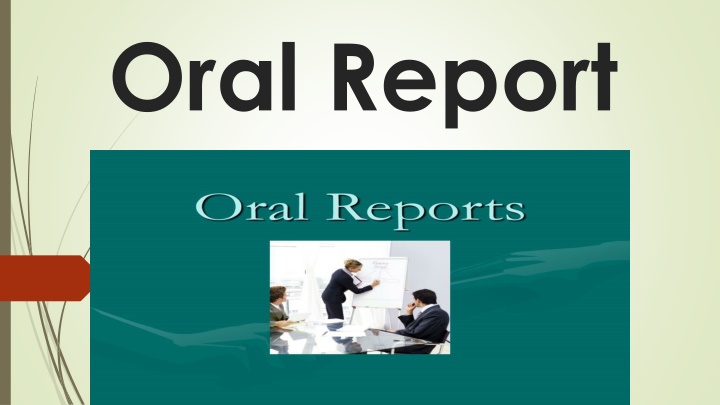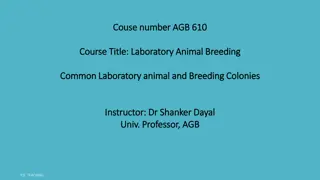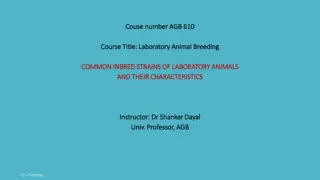
Mastering Oral Reports: Skills and Strategies for Effective Communication
Enhance your speaking skills and excel in oral reports with this comprehensive guide. Learn the differences between oral and written reports, discover tips for preparation, and understand the nuances of informal and formal presentations. Whether delivering to a small group or a large audience, this resource will help you communicate effectively and confidently in various settings.
Download Presentation

Please find below an Image/Link to download the presentation.
The content on the website is provided AS IS for your information and personal use only. It may not be sold, licensed, or shared on other websites without obtaining consent from the author. If you encounter any issues during the download, it is possible that the publisher has removed the file from their server.
You are allowed to download the files provided on this website for personal or commercial use, subject to the condition that they are used lawfully. All files are the property of their respective owners.
The content on the website is provided AS IS for your information and personal use only. It may not be sold, licensed, or shared on other websites without obtaining consent from the author.
E N D
Presentation Transcript
Introduction An oral report is an opportunity for students to practice their speaking skills, but other skills may come into play as well. An oral report is a report that is given orally and a written report is a report that we write and then transmit to our users. Oral reports are frequently used in the form of oral presentations and at different types of business meetings. In other cases, a written report is more appropriate. An oral report is an opportunity for students to practice their speaking skills, but other skills may come into play as well. An oral report is a report that is given orally and a written report is a report that we write and then transmit to our users. Oral reports are frequently used in the form of oral presentations and at different types of business meetings. In other cases, a written report is more appropriate.
Introduction In preparing for an oral report, a student's approach will vary somewhat depending on whether it must be delivered without notes. If the report has to be memorized, more practice will likely be required. If the student may speak from note cards or an outline.
Informal and Formal Oral Report An oral report may be delivered around a small table with just a few listeners or in a large auditorium to hundreds of people. Informal oral reports are generally characterized by small-group settings with a high degree of audience interaction and a relaxed manner of delivery and dress. An informal oral report might be an impromptu presentation. Informal oral presentations can foster the free exchange of ideas and be important for producing action items. A formal oral report is distinguished by its adherence to an agreed-upon format or outline.
Informal and Formal Oral Report Formal oral reports may follow an outline similar to the parts of any formal written report and may be presented to an audience of one's peers or to an interested general or mixed audience in a setting such as a large auditorium or hall. However, the size of a room or an audience does not solely define a formal situation. Formal oral reports may also include presentations to small in- house groups of managers or academic committees, Example. Presenting effective formal oral reports is an important means of establishing and maintaining your credentials and authority within a field or within an organization.
ORAL PRESENTATIONS- Oral presentations, also known as public speaking or simply presentations, consist of an individual or group verbally addressing an audience on a particular topic.
Purpose Oral presentations, also known as public speaking or simply presentations, consist of an individual or group verbally addressing an audience on a particular topic. The aim of this is to educate, inform, entertain or present an argument.
Advantage of oral presentations Allows for probing questions that test underlying assumptions. Quick feedback is possible. Allow students to demonstrate a logical flow/development of an idea.* Presentation skills are valued by employers. Students are familiar with this assessment method.
Talk to the Audience Know your audience their backgrounds and knowledge level of the material you are presenting and what they are hoping to get out of the presentation. Deliver what the audience wants to hear.
Less is more Your knowledge of the subject is best expressed through a clear and concise presentation that is provocative and leads to a dialog during the question and -answer session when the audience becomes active participants. At that point, your knowledge of the material will likely become clear.
Talk Only When You Have Something to Say Remember the audience's time is precious and should not be abused by presentation of uninteresting preliminary material.
Make the Take-Home Message Persistent A good rule of thumb is this: if you ask a member of the audience a week later about your presentation, he or she should be able to remember three points. If these are the key points you were trying to get across, you have done a good job. If they can remember any three points, but not the key points, then your emphasis was wrong. It is obvious what it means if they cannot recall three points.
Be Logical Think of the presentation as a story. There is a clear beginning, middle, and an end. You set the stage (beginning), you tell the story (middle), and you have a big finish (the end) where the take- home message is clearly understood.
Treat the Floor as a Stage Presentations should be entertaining, but do not overdo it and do know your limits. If you are not humorous by nature, do not try and be humorous. If you are not good at telling anecdotes, do not try and tell anecdotes, and so on. A good entertainer will captivate the audience and improve his or chances of following Rule 4.
Practice and Time Your Presentation The more you practice, the less likely you will be to go off on tangents. The more presentations you give, the better you are going to get. An important talk should not be given for the first time to an audience of peers. You should have delivered it to your research collaborators who will be kinder and gentler but still point out obvious discrepancies. Even more important, when you give the presentation, stick to what you practice.
Use Visuals Sparingly but Effectively If you have more than one visual for each minute you are talking, you have too many and you will Obviously some visuals are quick, others take time to get run over time. the message across. Avoid reading the visual unless you wish to emphasize the point explicitly. The visual should support what you are saying either for emphasis or with data to prove the verbal point. Finally, do not overload the visual. Make the points few and clear .
Review Audio and/or Video Presentations There is nothing more effective than listening to, or listening to and viewing, a presentation you have made. Seeing what is wrong is easy, correcting it the next time around is not. Work hard on breaking bad habits; it is important.
Provide Appropriate Provide Appropriate Acknowledgments& It is often appropriate to acknowledge people at the beginning or at the point of their contribution so that their contributions are very clear.
Summary An oral report is an opportunity for students to practice their speaking skills. So far, we have discussed about Introduction, define, oral presentations, purpose, advantage or oral presentations, enumerate the practice and time your presentations.


